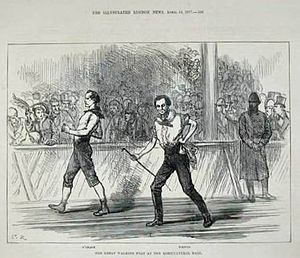6 Day Race
For the bicycle race see Six-day racing
The 6 Day Race became a standard distance in the 1870s and was a popular form of entertainment where up to 70,000 paying visitors, in 1877, came to watch the Pedestrians battle it out.
History
Edward Payson Weston in 1867 walked from Portland, Maine to Chicago, Illinois in 25 days, a distance of 2,134 km (1,326 mi), earning him $10,000 and national fame. In 1874 Weston walked his first six-day race and was challenged by Daniel O'Leary, who completed 500 miles (800 km) in 153 hours. The big battle took place in Chicago in November 1875 with O'Leary emerging victorious with 503 miles (810 km) and Weston finished with 451 miles (726 km).

In a re-match in 1877 O'Leary was victorious again and the excitement created enough interest for Sir John Dugdale Astley, a British Member of Parliament, to inaugurate a series of 6 day races to determine the "Long distance Champion of The World". These became known as the "Astley Belt" races and cash prizes were offered. O'Leary won the first two and was thwarted by Charles Rowell in his quest for three in a row. Weston won the fourth, setting a record of 550 miles (890 km) and Rowell won the final three multiday races to permanently keep the Astley Belt.
The first women's six-day race took place in 1879 and was won by Bertha Von Berg with 372 miles (599 km). In 1880, Fred Hitchborn set a new record of 565 miles (909 km) earning $17,000 dollars, a fortune at the time. By the early 1890s the six-day races were in decline and no longer drawing the public or offering large prizes. It wasn't until Don Choi hosted a 6 Day race in 1980 in California that interest began to grow again.
Briton Mike Newton became the first man to cover 500 miles/800km in a modern 6 day race at Nottingham in November 1981. In 1982, Tom O’Reilly took the six-day total to 576 miles/927km. In 1984 Yiannis Kouros twice ran over 1,022 km (635 mi) setting a new world record that would stand until 2005 when he broke his own record again with 1,036 km (644 mi) at the Cliff Young Australian 6-day race in Colac, Australia.
The women's world record was broken by Australia's Dipali Cunningham in 1998 when she covered 504 miles (811 km) at the Sri Chinmoy six-day race on Wards Island in New York in very wet conditions. In 2001 Cunningham set a new Women's road best of 510 miles (820 km).
Current 6 day Races
- Antibes 6 Day Race
- Arizona 6 Day
- No Finish Line 6 Day
- Pantano 6 Day Race
- Self-Transcendence 6 day
- South Africa 6 Day Circuit
- Unixsport 6 Day International Ultramarathon Challenge
External links
- 6 Jours D'Antibes.com
- Self-Transcendence
- Erkrath
- Multiday races
- ULTRAmarathonRunning.com Global Ultramarathon Races & Events Calendar
References
- Andy Milroy Yiannis Kouros - The Making of a Legend
- Andy Milroy The events and performances that have shaped ultrarunning
- Kelly Collins - The History of Multiday Running
Literature
- Ultramarathoning: The Next Challenge, by Tom Osler and Ed Dodd
- Ultrarunning magazine
- Multiday Running Magazine
- King of the Peds, by P.S. Marshall
